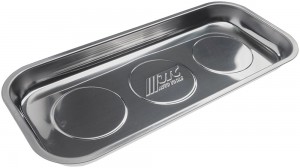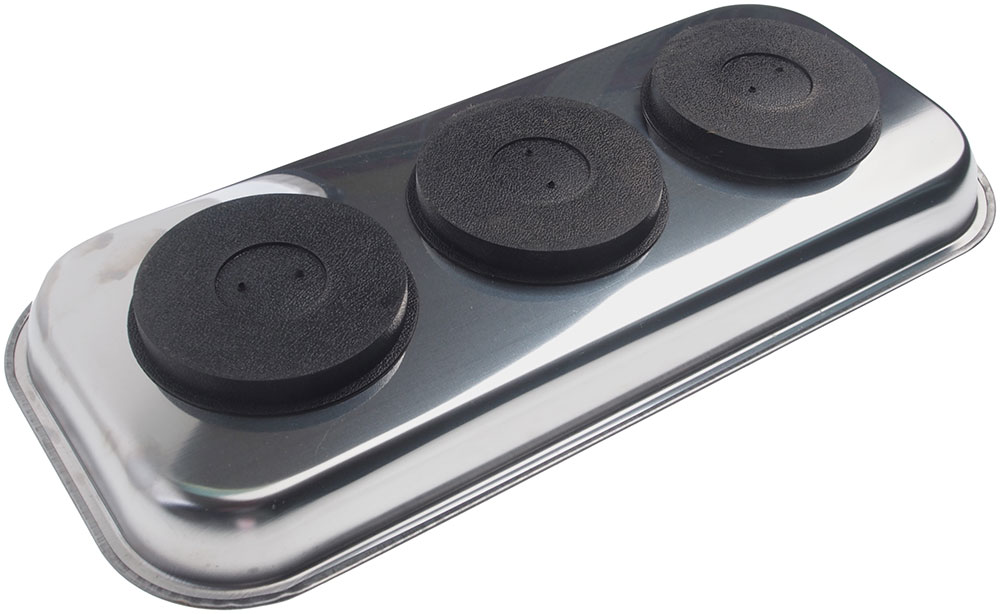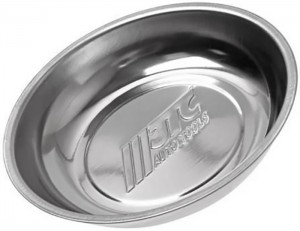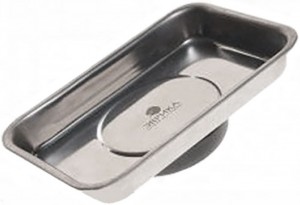
Screws, bolts and nuts laid out on the table or in a plastic container are easily lost and damaged. This problem in the temporary storage of hardware is solved by magnetic pallets. Read all about these devices, their types, design and device, as well as the selection and use of pallets in this article.
Purpose of the magnetic pallet for storage of fasteners
Magnetic pallet for storage of fasteners is specialized equipment for storing steel fasteners (hardware), made in the form of a pallet of one shape or another with magnets located in the bottom.
When performing repair, disassembly and assembly work, and in other situations, it is often necessary to temporarily store fasteners - screws, bolts, nuts, washers, small brackets and other steel parts. For this purpose, various pallets and random containers can be used, however, when they are overturned, there is a high probability of loss and damage to hardware. This problem is solved with the help of special devices - magnetic pallets for storing fasteners.
Magnetic pallets have several functions:
● Temporary storage of hardware made of magnetic materials;
● In large pallets - the ability to store unequal hardware in separate areas of one pallet;
● Prevention of spillage and loss of fasteners;
● In some cases, it is possible to fix the pallet on metal structural elements and store hardware in any convenient position (with slopes).
Magnetic trays for storing fasteners are a simple device that solves many problems at once. Due to their qualities, they have taken a strong place in auto repair shops, garages of motorists, in the assembly shops of industrial enterprises, etc. However, for the correct selection of the pallet, it is necessary to consider the existing types of these devices, their design and features.

Magnetic pallet is a convenient solution for temporary storage of fastener

The properties of the pallet are provided by magnetic washers located on the bottomW
Types, design and features of magnetic pallets
Structurally, all pallets on the market are the same. The basis of the device is a steel stamped container (bowl) of one shape or another, under the bottom of which one or more ring magnets or round magnets with a hole in the center (washers) are mounted. Magnets can be attached using countersunk screws passed through the bottom of the bowl, or on glue. Magnets for protection against damage are closed with plastic or metal covers, the magnetic washers assembled in this way simultaneously act as a support for the pallet.
The container is usually made of magnetic steel so that the parts stored in it are more or less evenly distributed over the bottom. The bowl has a streamlined shape without sharp corners and edges, which prevents hardware from getting stuck, makes it easier to work with the device and increases its safety. The design of the tank can provide for various auxiliary components: side handles (stamped in two opposite walls at the upper side), sides, internal partitions and others. The presence of such elements increases the ease of use of the pallet, and also increases its aesthetic qualities.
Magnetic pallets are divided into several groups according to the shape of the container (bowl) and the number of washers installed in it.
According to the shape of the product, there are:
- Round;
- Rectangular.
In round pallets, only one magnetic washer is installed in the center, such devices are similar to a basin of small diameter. Rectangular pallets can have one, two, three or four washers evenly distributed under the bottom. Pallets with one, two and three washers have an elongated bowl, the magnets are located under it in one row. Devices with four magnets have a shape close to square, the magnetic washers under its bowl are arranged in two rows (in the corners).
Pallets have dimensions in the range of 100-365 mm on the large side, their height rarely exceeds 40-45 mm. Round pallets rarely have a diameter of more than 160-170 mm.

Magnetic pallet round shape

Rectangular magnetic pallet with one magnetic washerT
How to choose and use magnetic pallets for fasteners
When choosing a magnetic pallet, you should take into account the nature of the work performed and the type of fasteners (hardware) that need to be stored. To perform work with small fasteners (for example, when repairing or assembling radio equipment, some automotive units, various devices), a round or rectangular pallet of small size, which does not take up much space, is optimal. On the contrary, when repairing a car in a garage or workshop, on assembly lines and in other situations where you have to work with a large number of large and small fasteners, oversized pallets are better suited.
Also, when buying a device, it is necessary to take into account the peculiarities of the workplace. In confined spaces, elongated rectangular pallets are best suited - with a small width, they will not interfere. If there is enough space, then both round and rectangular pallets with low elongation are suitable.
The operation of the pallet is extremely simple - just install it in a convenient place and fold the hardware. Thanks to the built-in magnets, the parts will not slide on the bottom of the pallet when tilting and carrying, and in some cases when falling from a small height. If conditions permit, the pallet can be placed on metal parts (table, rack and other structures), as a result of which it is securely placed without the risk of falling.
When working with a pallet, it should be remembered that magnets are quite heavy, so falling off the device can cause injury. Also, magnets are fragile, so careless use of the pallet can lead to breakage of washers and deterioration of their characteristics. If the magnet is damaged, it can be replaced (as it is held by a screw), but there may be problems with the acquisition of the necessary part.
With proper selection and proper use, the magnetic pallet will provide good assistance during repairs, on the assembly line and even in everyday life.
Post time: Jul-11-2023
